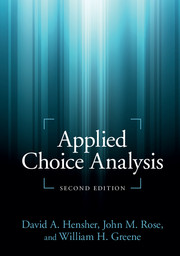Book contents
- Frontmatter
- Contents
- List of Figures
- List of Tables
- Preface
- Part I Getting started
- Part II Software and data
- Part III The suite of choice models
- 11 Getting started modeling: the workhorse – multinomial logit
- 12 Handling unlabeled discrete choice data
- 13 Getting more from your model
- 14 Nested logit estimation
- 15 Mixed logit estimation
- 16 Latent class models
- 17 Binary choice models
- 18 Ordered choices
- 19 Combining sources of data
- Part IV Advanced topics
- Select glossary
- References
- Index
18 - Ordered choices
from Part III - The suite of choice models
Published online by Cambridge University Press: 05 June 2015
- Frontmatter
- Contents
- List of Figures
- List of Tables
- Preface
- Part I Getting started
- Part II Software and data
- Part III The suite of choice models
- 11 Getting started modeling: the workhorse – multinomial logit
- 12 Handling unlabeled discrete choice data
- 13 Getting more from your model
- 14 Nested logit estimation
- 15 Mixed logit estimation
- 16 Latent class models
- 17 Binary choice models
- 18 Ordered choices
- 19 Combining sources of data
- Part IV Advanced topics
- Select glossary
- References
- Index
Summary
Introduction
A growing number of empirical studies involves the assessment of influences on a choice among ordered discrete alternatives. Ordered logit and probit models are well known, including extensions to accommodate random parameters (RP) and heteroskedasticity in unobserved variance (see, e.g., Bhat and Pulugurtha 1998; Greene 2007). The ordered choice model allows for non-linear effects of any variable on the probabilities associated with each ordered level (see, e.g., Eluru et al. 2008). However, the traditional ordered choice model is potentially limited, behaviorally, in that it holds the threshold values to be fixed. This can lead to inconsistent (i.e., incorrect) estimates of the effects of variables. Extending the ordered choice random parameter model to account for threshold random heterogeneity, as well as underlying systematic sources of explanation for unobserved heterogeneity, is a logical extension in line with the growing interest in choice analysis in establishing additional candidate sources of observed and unobserved taste heterogeneity.
A substantive application here is used to illustrate the behavioral gains from generalizing the ordered choice model to accommodate random thresholds in the presence of RP. It is focussed on the influences on the role that a specific attribute processing strategy, of preserving each attribute or ignoring it, plays when choosing among unlabeled attribute packages of alternative tolled and non-tolled routes for the commuting trip in a stated choice experiment (see Hensher 2001a, 2004, 2008). The ordering represents the number of attributes attended to from the full set. Despite a growing number of studies focussing on these issues (see, e.g., Cantillo et al. 2006; Hensher 2006; Swait 2001; Campbell et al. 2008), the entire domain of every attribute is treated as relevant to some degree, and included in the utility expressions for every individual. While acknowledging the extensive study of non-linearity in attribute specification, which permits varying marginal (dis)utility over an attribute’s range, including account for asymmetric preferences under conditions of gain and loss (see Hess et al. 2008), this is not the same as establishing ex ante the extent to which a specific attribute might be totally excluded from consideration for all manner of reasons, including the influence of the design of a choice experiment when stated choice data is being used.
- Type
- Chapter
- Information
- Applied Choice Analysis , pp. 804 - 835Publisher: Cambridge University PressPrint publication year: 2015



